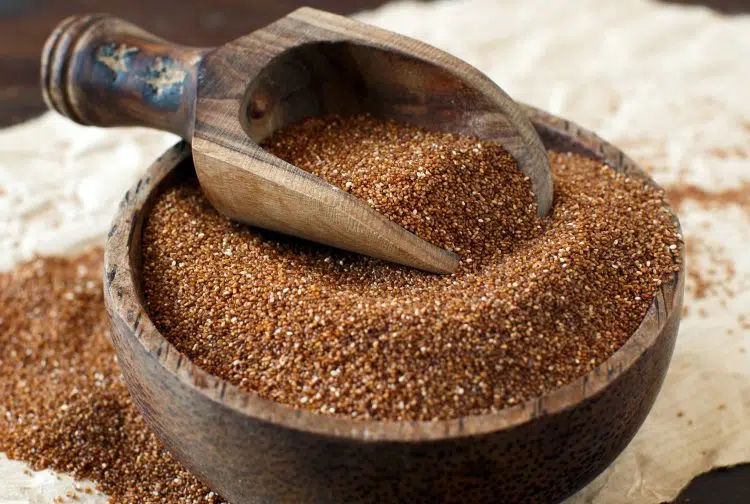A balanced diet of nutrient-dense whole foods is essential for achieving a strong, muscular physique and optimal health.
As a personal trainer with over seven years of experience, I’m often asked about the best protein powder for building muscle. My answer is always the same: protein supplements aren’t always necessary.
Teff, an ancient Ethiopian superfood, is a nutrient powerhouse. This gluten-free grain is packed with protein, fiber, essential minerals, and a complete amino acid profile. Plus, its delicious nutty flavor has earned rave reviews.
Intrigued by teff’s potential, I embarked on a three-month experiment, replacing my protein shakes with teff-based meals and snacks. In this article, I delve into the details and results of this experiment.
Nutritional Value
This whole grain packs a serious nutritional punch. Here is an overview of its nutritional profile: (1)
| Nutrient | Amount per 100g of Cooked Teff | Why You Care (Bodybuilder Edition) |
| Calories | 367 | Total amount of energy |
| Protein | 13.3g | Muscle repair and growth |
| Carbs | 73g | Sustained energy for intense workouts |
| Fiber | 8g | Gut health and blood sugar control |
| Iron | 8mg | Oxygen transport and energy production |
| Calcium | 180mg | Bone health and muscle function |
| Lysine | High levels | Essential amino acid for muscle building |

While 13.3 grams of protein might not sound like a lot, you must remember that this is real food and shouldn’t be directly compared with something prepared in a lab by people wearing white coats.
Level Up Your Fitness: Join our 💪 strong community in Fitness Volt Newsletter. Get daily inspiration, expert-backed workouts, nutrition tips, the latest in strength sports, and the support you need to reach your goals. Subscribe for free!
Teff’s protein quality is much better than that of supplements. It boasts a complete amino acid profile, meaning it contains all nine essential amino acids that your body needs but cannot produce on its own.
Teff: The Ancient Supergrain
The fitness world is full of fads, and as someone who has been in the field for a long time, I’m especially careful not to fall for one.
Teff has been around for ages (over 5,000 years) and has helped people nourish their bodies and minds. Furthermore, it is a staple food in many African cultures.
Need more reason to adopt teff? Ethiopian runners, known for their endurance, have relied on teff for sustained energy and muscle recovery.
Benefits of Teff
Adding teff to your diet entails the following advantages:
- Enhances Protein Synthesis: Teff boasts a complete amino acid profile, which can boost the muscle repair and rebuilding process. (2)
- Can Help Prevent Osteoporosis: Osteoporosis is a bone disease that develops when bone mineral density and bone mass decrease or when the structure and strength of bone change. Teff prevents this. (3)
- Boosts gut health: Since teff has a high fiber content, it improves the good bacteria in your gut, enhancing your digestion and overall well-being.
- Stabilizes blood sugar: This whole grain has a low glycemic index, which prevents spikes and crashes that can hamper your energy levels and workouts.
- Reduces inflammation: Studies suggest that adding teff to your diet can have anti-inflammatory benefits, aiding recovery and reducing muscle soreness after training. (4)
My Teff-Fueled 12-Week Fitness Journey
Here is a detailed look at my journey with teff:
Diet Overhaul
Since this was a three-month challenge, I dove headfirst into it to ensure I wasn’t leaving any gains on the table.
I made this grain the primary protein and carbohydrate source in my diet, but remember, this wasn’t a complete replacement. Think of it as more of an integration.
Eliminating certain foods from your diet can create gaps, which can result in nutrient deficiencies.
Training Tweaks
I made no major changes to my training and stuck with my usual programming (push-pull-legs) to focus on hypertrophy. The goal of this 12-week challenge was to see how teff could affect my performance and recovery.
Tracking
I maintained a detailed journal of every meal, workout, and physique progress to ensure I was moving in the right direction. Plus, I used a body composition analyzer to track changes in muscle mass and body fat. I recommend you do the same.
Sample Teff-Focused Meal Plan
Teff is an incredibly versatile food source that can be used in any meal. Here is how I incorporated it into my routine:
- Breakfast: Teff porridge with berries and nuts.
- Lunch: Teff salad with grilled chicken or fish.
- Dinner: Teff stir-fry with veggies and tofu.
- Snacks: Teff energy balls or bars.
You can always start with adding teff to one meal and build from there. It might take some time to get used to the nutty flavor of this grain.
Level Up Your Fitness: Join our 💪 strong community in Fitness Volt Newsletter. Get daily inspiration, expert-backed workouts, nutrition tips, the latest in strength sports, and the support you need to reach your goals. Subscribe for free!
Tracking Progress
I started noticing changes in my physique from the third week — my muscles felt fuller, my recovery was faster, and my energy levels were through the roof. It also helped me improve my one-rep max (1RM) on lifts like the bench press, squat, and deadlift. However, I must mention that this diet coincided with a bulking mesocycle, which could have played a big role in the strength gains.
The body composition calculator confirmed that I was gaining lean muscle mass while shedding body fat. My body fat went from 17.5 to 15.2 percent without any noticeable muscle loss. Who doesn’t love that?
Challenges and Solutions of Using Teff
Make no mistake, adding teff to your diet plan isn’t a walk in the park, especially when you’re planning to go as hard as I did. Here are some challenges and adherence tips that can help you with the new lifestyle change:
Conquering Challenges
Here are the most common hurdles and how you can tackle them:
Sourcing
Depending on where you live, teff might not be readily available in your local supermarket. However, you can easily get it through online retailers that specialize in unique grains. It might be a hassle to get the grain initially, but it will totally be worth it in the long term.
Taste Test
As mentioned earlier, teff has a nutty flavor, and it might take you some time to adjust to it. I know people who find teff slightly bitter and prefer consuming it with something sweet like honey.
That said, teff is a very versatile food source. You can add cinnamon, lemon, or any other similar ingredient to change its flavor profile. I can assure you that even the most pickiest of people can make teff work with a little experimentation.
Sustainability Superpowers
Teff is not just a superfood because of the effects it has on your physique. It is just as beneficial for the environment.
Saves Water
Teff grows (and thrives) in drought conditions. Compared to thirsty protein sources like beef, teff’s ecological footprint is remarkably small. Not just that, you also don’t feel as thirsty after eating teff as you do with meat.
Nutritious For Soil
Teff enriches the soil as it grows and requires minimal fertilizers. Thus, it effectively nourishes your muscles and Mother Nature simultaneously.
All this makes teff sound like an angel grain.
Tips To Include Teff In Your Diet
These tips can help integrate teff into your diet:
- Prep Power: I highly recommend cooking a large batch of teff in one go, as it keeps well in the refrigerators and makes sticking to a healthy diet much more convenient.
- Mix and Match: Add teff to salads, soups, or stir-fries for a protein-packed punch.
- Smoothies: Blend cooked teff into your morning smoothie. It adds creaminess and a nutty flavor, which is absolutely heavenly.
- Get Creative: Go crazy with it. Use the teff flour to make protein-rich muffins, pancakes, and even pizza crusts. You are only limited by your own imagination. (5)
Remember, my experience with teff is just that — my experience. Your results can vary depending on multiple factors including age, gender, body composition, activity levels, and genetics.
Nonetheless, you will be pleased with this experience and the results. This superfood is a game-changer and has become one of my favorite whole grains.
While I am no longer using the exact diet explained above, I consume teff at least once daily for its amazing benefits (and taste).
Conclusion
Teff is a nutritional powerhouse that puts the average protein shake to shame. Using teff as a protein shake replacement improved my overall strength, energy levels, recovery time, and rate of muscle growth.
If you’re bored of chugging down a protein shake every day and instead want to switch to a whole-food alternative, I would highly recommend adding teff to your diet plan. Start small and use it as a snack before making it a constant in your diet.
If you have any questions about teff and how to add it to your diet, drop them in the comments below, and I’ll be happy to help!
References
- U.S. Department of Agriculture. FoodData Central: Basil, fresh [Internet]. Available from: https://fdc.nal.usda.gov/fdc-app.html#/food-details/169747/nutrients. Accessed July 19, 2024.
- Tura, D. C., Belachew, T., Tamiru, D., & Hassen Abate, K. (2024). Energy, protein and iron densities of dabi teff-field pea-based optimised novel complementary flour and its contribution to daily energy and nutrients demand by 6-23-month-old children. The British journal of nutrition, 131(6), 1015–1030. https://doi.org/10.1017/S0007114523002581
- Asfha, D., Mishra, T., & Vuppu, S. (2022). Teff Grain-Based Functional Food for Prevention of Osteoporosis: Sensory Evaluation and Molecular Docking Approach. Plant foods for human nutrition (Dordrecht, Netherlands), 77(4), 568–576. https://doi.org/10.1007/s11130-022-01012-y
- Lemecha M, Morino K, Seifu D, et al. Improved glucose metabolism by Eragrostis tef potentially through beige adipocyte formation and attenuating adipose tissue inflammation. PLoS One. 2018;13(8):e0201661. Published 2018 Aug 2. doi:10.1371/journal.pone.0201661
- Dingeo, C., Difonzo, G., Paradiso, V. M., Rizzello, C. G., & Pontonio, E. (2020). Teff Type-I Sourdough to Produce Gluten-Free Muffin. Microorganisms, 8(8), 1149. https://doi.org/10.3390/microorganisms8081149










